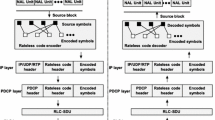Abstract
By exploiting new human-machine interface techniques, such as visual eyetrackers, it should be possible to develop more efficient visual multimedia services associated with low bandwidth, dynamic channel adaptation and robust visual data transmission. In this paper, we introduce foveation-based error resilience and unequal error protection techniques over highly error-prone mobile networks. Each frame is spatially divided into foveated and background layers according to perceptual importance. Perceptual importance is determined either through an eye tracker or by manually selecting a region of interest. We attempt to improve reconstructed visual quality by maintaining the high visual source throughput of the foveated layer using foveation-based error resilience and error correction using a combination of turbo codes and ARQ (automatic reQuest). In order to alleviate the degradation of visual quality, a foveation based bitstream partitioning is developed. In an effort to increase the source throughput of the foveated layer, we develop unequal delay-constrained ARQ (automatic reQuest) and rate compatible punctured turbo codes where the punctual pattern of RCPC (rate compatible punctured convolutional) codes in H.223 Annex C is used. In the simulation, the visual quality is significantly increased in the area of interest using foveation-based error resilience and unequal error protection; (as much as 3 dB FPSNR (foveal peak signal to noise ratio) improvement) at 40% packet error rate. Over real-fading statistics measured in the downtown area of Austin, Texas, the visual quality is increased up to 1.5 dB in PSNR and 1.8 dB in FPSNR at a channel SNR of 5 dB.
Similar content being viewed by others
References
R. Talluri, "Error-Resilient Video Coding in the ISO MPEG-4 Standard," IEEE Commun. Mag., 1998, pp. 112-119.
"Description of Error Resilient Core Experiments," Tech. Rep., ISO/IEC JTC1/SC29/WG11 N1646 MPEG97, April 1997.
"MPEG-4 Video Verification Model Version 13.0," Tech. Rep., ISO/IEC JTC1/SC29/WG11, May 1999.
"Draft Text of Recommendation H.263Version 2 ("h.263+") for Decision," Tech. Rep., ITU Telecom. Standardization Section of ITU, Sept. 1997.
S. Lee, M.S. Pattichis, and A.C. Bovik, "FoveatedVideo Quality Assessment," IEEE Trans. Multimedia, 2002.
S. Lee, M.S. Pattichis, and A.C. Bovik, "Foveated Video Compression with Optimal Rate Control," IEEE Trans. Image Processing, vol. 10, 2001, pp. 977-992.
S. Lee, A.C. Bovik, and B.L. Evans, "Efficient Implementation of Foveation Filtering," in Proc. Texas Instruments DSP Educator's Conference, Houston, TX, Aug. 1999.
S. Lee, C. Podilchuk, and A.C. Bovik, "Foveation-Based Error Resilience for Video Transmission over Mobile Networks," in Proc. IEEE International Conference on Multimedia and Expo, New York City, July 2000.
S. Lee, C. Podilchuk, V. Krishnan, and A.C. Bovik, "Unequal Error Protection for Foveation-Based Error Resilience over Mobile Networks," in Proc. IEEE Int'l. Conf. Image Proc., Vancouver, Canada, Sept. 2000.
S. Lee, A.C. Bovik, and Y.Y. Kim, "Low Delay Foveated Visual Communications over Wireless Channels," in Proc. IEEE ICIP'99, Kobe, Japan, Oct. 1999.
S. Lee and A.C. Bovik, "Motion Estimation and Compensation for Foveated Video," in Proc. IEEE ICIP'99, Kobe, Japan, Oct. 1999.
"Multiplexing Protocol for Low Bit Rate Multimedia Mobile Communication over Highly Error-Prone Channels,"Tech. Rep., ITU T Rec. H.223 Annex C, Feb. 1998.
J.L. Mannos and D.J. Sakrison, "The Effects of a Visual Fidelity Criterion on the Encoding of Images," IEEE Trans. Inform. Theory, vol. 20, 1974, pp. 525-536.
W.S. Geisler and J.S. Perry, "A Real-Time Foveated Multiresolution System for Low-Bandwidth Video Communincation," in SPIE Proceedings, vol. 3299, 1998.
M.S. Banks, A.B. Sekuler, and S.J. Anderson, "Peripheral Spatial Vision: Limits Imposed by Optics, Photoreceptors, and Receptor Pooling," J. Opt. Soc. Amer., vol. 8, 1991, pp. 1775-1787.
T.L. Arnow and W.S. Geisler, "Visual Detection Following Retinal Damage: Predictions of an Inhomogeneous Retino-Cortical Model," in SPIE Proceedings: Laser-Inflicted Eye Injuries, vol. 2674, 1996, pp. 119-130.
J.J. Clark, M.R. Palmer, and P.D. Lawrence, "A Transformation Method for the Reconstruction of Functions from Nonuniformly Spaced Samples," IEEE Trans. on Acoust., Speech, Signal Processing, vol. 33, 1985, pp. 1151-1165.
Y. Zeevi and E. Shlomot, "Nonuniform Sampling and Antialiasing in Image Representation," IEEE Trans. on Signal Processing, vol. 41, 1993, pp. 1223-1236.
M.S. Pattichis and A.C. Bovik, "AM-FM Expansions for Images," in Proc. European Signal Processing Conf., Trieste, Italy, Sept. 1996.
S. Lee and A.C. Bovik, "Very Low Bit Rate Foveated Video Coding for H.263," in Proc. IEEE ICASSP'99, Phoenix, AZ, March 1999, pp. VI3113-VI3116.
A. Basu and K.J. Wiebe, "Enhancing Videoconferencing Using Spatially Varying Sensing," IEEE Trans. Syst., Man, Cybern.-Part A: Systems and Humans, vol. 28, 1998, pp. 137-148.
S. Daly, K. Matthews, and J. Ribas-Corbera, "Visual Eccentricity Models in Face-Based Video Compression," in Proc. of SPIE (Human Vision and Electronic Imaging IV), San Jose, Jan. 1999, vol. 3644.
B.A. Wandell, Foundations of Vision, Sunderland, MA: Sinauer Associates, Inc, 1994.
M. Luttrell and J.D. Villasenor, "Proposal for Data Partitioning Annex to H.263," Tech. Rep., ITU-T Documentation Q15-G-13, Monterey, Feb. 1999.
C. Berrou, A. Glavieux, and P. Thitimajshima, "Near Shannon Limit Error Correcting Coding and Decoding: Turbo-Codes," in Proc. IEEE ICC, Geneva, Switzerland, May 1993, pp. 1064-1070.
L.R. Bahl, J. Cocke, F. Jelinek, and J. Rajiv, "Optimal Decoding of Linear Codes for Minimising the Symbol Error Rate," IEEE Trans. Inform. Theory, pp. 284-287, 1974.
E.K. Hall and S.G. Wilson, "Design and Analysis ofTurbo Codes on Rayleigh Fading Channels," IEEE J. Selected Areas Commun., vol. 16, 1998, pp. 160-173.
W.C.Y. Lee, "Estimate of Local Average Power of a Mobile Radio Signal," IEEE Trans. Vehicular Technology, vol. VT-34, 1985, pp. 22-27.
W.C.Y. Lee, "Elements of Cellular Mobile Radio Systems," IEEE Trans. Vehicular Technology, vol. VT-35, 1986, pp. 48-56.
H. Ling, "Wireless Channel Modeling," available at http://ling0.ece.utexas.edu/comm/comms.html, 1997.
S. Lee and A.C. Bovik, "Foveated Video Demonstration," available at http://pineapple.ece.utexas.edu/class/Video/demo.html, 1999.
Author information
Authors and Affiliations
Rights and permissions
About this article
Cite this article
Lee, S., Podilchuk, C., Krishnan, V. et al. Foveation-Based Error Resilience and Unequal Error Protection over Mobile Networks. The Journal of VLSI Signal Processing-Systems for Signal, Image, and Video Technology 34, 149–166 (2003). https://doi.org/10.1023/A:1022970707332
Published:
Issue Date:
DOI: https://doi.org/10.1023/A:1022970707332




